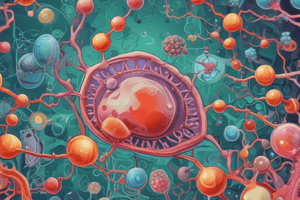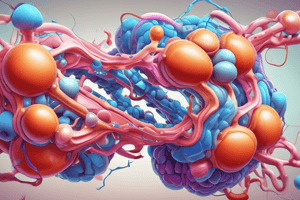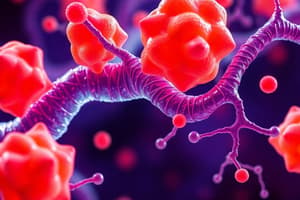Podcast
Questions and Answers
What is the main function of retinoic acid in the body?
What is the main function of retinoic acid in the body?
- Acts as a fuel source for energy production
- Binds to a nuclear receptor to induce gene expression (correct)
- Functions as a redox coenzyme in the electron transport chain
- Serves as a barrier around cells and organelles
Which of the following statements about ubiquinone is true?
Which of the following statements about ubiquinone is true?
- It is exclusively found in plant cells.
- It only exists in its oxidized form.
- It is a form of vitamin A.
- It acts as a redox cofactor in the electron transport chain. (correct)
Which vitamin serves primarily as an antioxidant?
Which vitamin serves primarily as an antioxidant?
- Vitamin A
- Vitamin E (correct)
- Vitamin D
- Vitamin K
What characteristic defines lipid-soluble vitamins?
What characteristic defines lipid-soluble vitamins?
What role does vitamin K play in the body?
What role does vitamin K play in the body?
What role does phosphatidylserine (PS) play in healthy cells?
What role does phosphatidylserine (PS) play in healthy cells?
Which lipid is phosphorylated by phosphatidylinositol 3-kinase (PI3K)?
Which lipid is phosphorylated by phosphatidylinositol 3-kinase (PI3K)?
What happens to phosphatidylinositol (PI) in signaling pathways?
What happens to phosphatidylinositol (PI) in signaling pathways?
What are the products of PIP2 hydrolysis by phospholipase C (PLC)?
What are the products of PIP2 hydrolysis by phospholipase C (PLC)?
What is the role of inositol 1,4,5-trisphosphate (IP3) in signaling?
What is the role of inositol 1,4,5-trisphosphate (IP3) in signaling?
What is the effect of diacylglycerol (DAG) in signaling pathways?
What is the effect of diacylglycerol (DAG) in signaling pathways?
Which of the following best summarizes the role of glycerophospholipids?
Which of the following best summarizes the role of glycerophospholipids?
In what cellular condition does phosphatidylserine (PS) translocate to the outer leaflet?
In what cellular condition does phosphatidylserine (PS) translocate to the outer leaflet?
What role do glycosphingolipids play in the plasma membrane?
What role do glycosphingolipids play in the plasma membrane?
Which of the following is a type of steroid hormone produced by the gonads?
Which of the following is a type of steroid hormone produced by the gonads?
What is the primary function of glucocorticoids such as cortisol?
What is the primary function of glucocorticoids such as cortisol?
What type of molecules are terpenoids derived from?
What type of molecules are terpenoids derived from?
What is the function of mineralocorticoids like aldosterone?
What is the function of mineralocorticoids like aldosterone?
Which aspect of retinal allows it to function as a signaling lipid in the visual system?
Which aspect of retinal allows it to function as a signaling lipid in the visual system?
Which of the following is NOT an effect of steroid hormones?
Which of the following is NOT an effect of steroid hormones?
Vitamin D is primarily involved in which physiological process?
Vitamin D is primarily involved in which physiological process?
What is the primary function of phospholipase A (PLA) enzymes?
What is the primary function of phospholipase A (PLA) enzymes?
Which of the following is a precursor molecule for eicosanoid signaling molecules?
Which of the following is a precursor molecule for eicosanoid signaling molecules?
What type of signaling role do eicosanoids typically serve?
What type of signaling role do eicosanoids typically serve?
Which statement correctly describes prostaglandins?
Which statement correctly describes prostaglandins?
What is the effect of nonsteroidal anti-inflammatory drugs (NSAIDs) on prostaglandins?
What is the effect of nonsteroidal anti-inflammatory drugs (NSAIDs) on prostaglandins?
What is the role of palmitic acid in post-translational modification?
What is the role of palmitic acid in post-translational modification?
How do sphingolipids function in cellular signaling?
How do sphingolipids function in cellular signaling?
What is the most common type of glycolipid found in mammals?
What is the most common type of glycolipid found in mammals?
Flashcards
Phosphatidylserine (PS)
Phosphatidylserine (PS)
A type of glycerophospholipid found in cell membranes, acting as a signal when it moves to the outer leaflet.
Apoptosis
Apoptosis
A process where cells dismantle themselves, releasing PS to the outer membrane for macrophage recognition.
Phosphatidylinositol (PI) and its derivatives
Phosphatidylinositol (PI) and its derivatives
Glycerophospholipids that serve as structural components of cell membranes and also as signaling molecules.
Phosphatidylinositol 4,5-bisphosphate (PIP2)
Phosphatidylinositol 4,5-bisphosphate (PIP2)
Signup and view all the flashcards
Phosphatidylinositol 3-kinase (PI3K)
Phosphatidylinositol 3-kinase (PI3K)
Signup and view all the flashcards
Inositol 1,4,5-trisphosphate (IP3)
Inositol 1,4,5-trisphosphate (IP3)
Signup and view all the flashcards
Phospholipase C (PLC)
Phospholipase C (PLC)
Signup and view all the flashcards
Diacylglycerol (DAG)
Diacylglycerol (DAG)
Signup and view all the flashcards
Arachidonic Acid
Arachidonic Acid
Signup and view all the flashcards
Prostaglandin
Prostaglandin
Signup and view all the flashcards
Nonsteroidal Anti-inflammatory Drugs (NSAIDs)
Nonsteroidal Anti-inflammatory Drugs (NSAIDs)
Signup and view all the flashcards
Post-Translational Modification
Post-Translational Modification
Signup and view all the flashcards
Palmitic acid
Palmitic acid
Signup and view all the flashcards
Sphingolipids
Sphingolipids
Signup and view all the flashcards
Glycosphingolipids
Glycosphingolipids
Signup and view all the flashcards
What are glycosphingolipids and where are they found?
What are glycosphingolipids and where are they found?
Signup and view all the flashcards
What are terpenoids?
What are terpenoids?
Signup and view all the flashcards
What are steroid hormones and what are they derived from?
What are steroid hormones and what are they derived from?
Signup and view all the flashcards
What do sex steroid hormones affect?
What do sex steroid hormones affect?
Signup and view all the flashcards
What is the function of glucocorticoids?
What is the function of glucocorticoids?
Signup and view all the flashcards
What do mineralocorticoids regulate?
What do mineralocorticoids regulate?
Signup and view all the flashcards
What is the function of vitamin D?
What is the function of vitamin D?
Signup and view all the flashcards
How does retinal function in the visual system?
How does retinal function in the visual system?
Signup and view all the flashcards
What is Vitamin E's role?
What is Vitamin E's role?
Signup and view all the flashcards
What role do lipids play in the Electron Transport Chain (ETC)?
What role do lipids play in the Electron Transport Chain (ETC)?
Signup and view all the flashcards
What are lipid-soluble vitamins?
What are lipid-soluble vitamins?
Signup and view all the flashcards
What are the lipid-soluble vitamins?
What are the lipid-soluble vitamins?
Signup and view all the flashcards
What is the function of retinoic acid?
What is the function of retinoic acid?
Signup and view all the flashcards
Study Notes
Introduction to Signaling Lipids
- Lipids have roles beyond energy storage and structure
- They act as signaling molecules, regulators, and coenzymes
- This section highlights the signaling roles of lipids, not their detailed pathways
Signaling Lipids from Hydrolyzable Membrane Lipids
- Membrane lipids are essential components for all cells and organelles
- Phosphatidylserine (PS) is a glycerophospholipid primarily on the inner leaflet of healthy cells
- In apoptotic cells, PS moves to the outer leaflet
- This outer leaflet PS signals macrophages to engulf the apoptotic cells
Phosphatidylinositol (PI) and its Derivatives
- PI and its derivatives are both structural and signaling lipids, examples include PIP2 and PIP3
- PIP2 can be phosphorylated by PI3K to produce PIP3
- Membrane PIP3 activates downstream effectors related to cell growth and neuronal plasticity
Hydrolysis of Lipids
- Phospholipase C (PLC) hydrolyzes PIP2 into inositol 1,4,5-trisphosphate (IP3) and diacylglycerol (DAG)
- IP3 triggers calcium release, and DAG activates protein kinase C (PKC)
- Phospholipase A (PLA) hydrolyzes fatty acids from the phospholipid molecule
- These hydrolyzed fatty acids can act as signaling molecules (e.g., arachidonic acid)
Arachidonic Acid and Eicosanoids
- Arachidonic acid is a 20-carbon polyunsaturated fatty acid important for eicosanoid production
- Eicosanoids (prostaglandins, leukotrienes, thromboxanes) are paracrine/autocrine signals in processes of injury and inflammation
- Prostaglandins involve a cyclic five-membered ring and are often targeted by NSAIDs (non-steroidal anti-inflammatory drugs)
Other Terpenoid Lipids and Modifications
- Fatty acids can modify proteins and regulate their activity
- Examples include palmitoylation, which can move proteins to or from the membrane, and other lipid modifications
- Retinal (derived from vitamin A) is a light-sensing protein in the visual system, affecting rhodopsin
- Retinoic acid regulates gene expression similarly to steroid hormones
- Ubiquinone (Coenzyme Q) plays a role in the electron transport chain
Steroid Hormones
- Steroids are derived from cholesterol and function in processes like development, energy metabolism, and immune responses
- Examples include sex hormones (estrogen, testosterone), glucocorticoids (cortisol), and mineralocorticoids (aldosterone)
- Steroid hormones are hydrophobic, traveling through the bloodstream bound to carrier proteins
- They enter target cells and bind intracellular receptors, regulating gene expression
Other Lipid Signaling Molecules
- Glycosphingolipids have carbohydrate groups that can act as recognition signals
- Blood types (A, B, O) are examples of this type of blood cell signaling
Studying That Suits You
Use AI to generate personalized quizzes and flashcards to suit your learning preferences.




